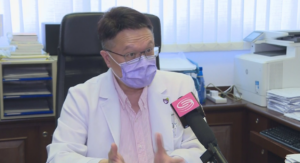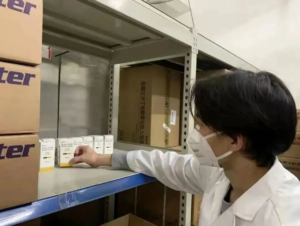
Beijing CDC experts explain the difference between vaccines for inhalation and nasal spray vaccines
China has started the second dose of booster vaccination. Today, Li Juan, a researcher at the Institute of Immunoprophylaxis of the Beijing Center for Disease Control and Prevention, gave a popularization on two new vaccines – inhalation vaccine and nasal spray vaccine.
Q: What is the inhalation vaccine? What is nasal spray vaccine?
Li Juan: The full name of inhalation vaccine is adenovirus-vectored neo-coronavirus vaccine for inhalation, and the full name of nasal spray vaccine is nasal spray influenza virus-vectored neo-coronavirus vaccine. There are three main differences between the two vaccines, one is the different modes and routes of vaccination, the second is the different R&D and production processes, and the third is the different procedures for booster vaccination.

People are vaccinated with nasal spray vaccine at the vaccination site of New Crown vaccine in Dongfeng area, Chaoyang, Beijing, Dec. 16, 2022.
Q: What are the differences between the two vaccines mentioned above in terms of the way they are administered?
Li Juan: In simple terms, the inhalation vaccine is inhaled through the mouth and requires a five-second breath-holding process after the vaccination is completed, while the nasal spray vaccine is injected through the nose and requires five short inhalations after the vaccination is completed.
Specifically, the inhalation vaccine is administered by using a nebulizer to nebulize the vaccine into tiny particles, which are collected in a nebulizer cup and then inhaled by the vaccine recipient through the mouth. For the vaccinator, the inhalation process can be briefly summarized as deep exhalation, slow inhalation, and brief breath holding in three steps to complete the vaccination. In the first step, the vaccinator first exhales deeply; in the second step, the vaccinator holds the nozzle of the nebulized cup in the mouth and inhales slowly and deeply until no white foggy gas can be seen in the cup; in the third step, after the inhalation is completed and then holds the breath for more than 5 seconds, he/she can breathe normally.
The nasal spray vaccine is administered by a nasal spray device, which is used by the health care provider to suck up the vaccine and spray it into the nasal cavity on both sides of the vaccine recipient. For the vaccinator, the process of nasal spraying can be summarized as a three-step process of tilting the head back, nasal spraying and short inhalation to complete the vaccination. In the first step, the vaccinator sits down with the mouth closed and the head tilted back at 45 degrees; in the second step, the healthcare provider sprays the vaccine into the deep nasal cavity twice in succession; in the third step, after the spraying is completed, the vaccinator continues to keep the head tilted back for 10 seconds and inhales 5-6 times in short bursts to inhale the vaccine into the respiratory tract.
Q: Can vaccine by inhalation and nasal spray be used for basic immunization? Which stage of vaccination are they suitable for respectively?
Lijuan: Currently, the inhalation vaccine and nasal spray Neocrown vaccine cannot be used for basic immunization.
The inhalation vaccine can be used for the first booster and second booster immunization. The nasal spray Neocrown vaccine can only be used for the second booster immunization.
For example, for people who have received two doses of inactivated vaccine or one dose of injectable adenovirus vector vaccine and have completed their primary immunization, the first booster immunization can be administered with the inhaled Neocrown vaccine.
For those who have completed their first booster immunization, regardless of whether the first booster is inactivated vaccine, recombinant protein vaccine, or injectable or inhaled adenovirus vector vaccine, a second booster can be administered with inhaled or nasal spray Neocrown vaccine.
Q: Are the two vaccines, inhalation and nasal spray, suitable for the elderly? What are the considerations for seniors choosing these two vaccines?
Lijuan: Currently, both inhalation vaccine and nasal spray vaccine are available for people aged 18 years and above, and both vaccines are suitable for elderly people aged 60 years and above.
The precautions for the two vaccines are basically the same as for the other vaccines, and the doctor will ask questions to assess the health condition before vaccination to determine if the vaccine is suitable. Generally speaking, those who have not experienced acute allergic reactions or severe allergic reactions such as respiratory distress after previous vaccinations, those who do not suffer from serious neurological diseases, and even those who suffer from chronic diseases can be vaccinated as long as they are under stable control and not in acute attack.
Q: At this stage, who can receive the second dose of “booster” vaccination?
Li Juan: At this stage, the second dose of booster vaccination can be given only after 6 months of the first dose of booster vaccination. The priority groups recommended include those at high risk of infection, elderly people aged 60 and above, people with more serious underlying diseases and people with low immunity. People who have recently been infected with the New Coronavirus are not recommended to receive the New Coronavirus vaccine for the time being.
Q: Do I still need to receive the vaccine after a “positive pass”? How long is the interval between vaccinations?
Lijuan: You still need to receive the vaccine after a “positive pass”, but there should be at least 6 months between the time of infection and the time of vaccination. Studies have shown that the mixed immunity from infection and vaccination is better than the immunity from infection with the new coronavirus alone. Also, from the surveillance data, the probability of re-infection within 6 months after infection with neo-coronavirus in healthy adults is relatively low; therefore, currently, China requires that at least 6 months should elapse after infection with neo-coronavirus before vaccination. As vaccine research progresses and the need to prevent and control the disease, the national immunization strategy for the new crown, including the vaccination interval, will be improved and adjusted accordingly.


Average Rating